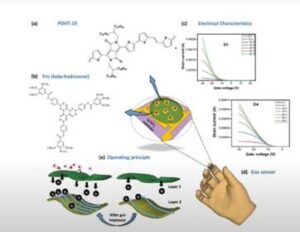In News: Scientists have developed an electronic nose with biodegradable polymer and monomer that can detect hydrogen sulphide (H2S), a poisonous, corrosive, and flammable gas produced from swamps and sewers.
About New Electronic Nose
- H2S is the primary gas produced from the microbial breakdown of organic matter in the absence of oxygen, and this necessitates easy detection of its emission from sewers and swamps.
- Scientists from the Centre for Nano and Soft Matter Sciences (CeNS), Bangalore, in collaboration with their counterparts from Saudi Arabia.
- Developed an exceptionally sensitive and selective H2S Gas sensor developed by impersonating the neuron responsible for identification of airborne molecules or olfactory receptor neuron (ORN).
Mechanism of Action New Electronic Nose
- The impersonation of ORN with the help of an organic electronic device consisting of biodegradable polymer and monomer.
- The fabricated sensor consists of a heterostructure consisting of two layers
- The top layer:A monomer and realized with a novel chemical tris (keto-hydrazone), which is both porous and contains H2S specific functional groups.
- The bottom layer: Is the active channel layer which plays a key role in altering the current and mobility of charge carriers.
- Thus the synergistic combination helps to pre-concentrate the H2S molecules, initiate an acid-base chemical reaction, and thereby brings a change in the majority carriers (holes) of the channel region in the device.
- The capacitance sensor (a sensor that detects nearby objects by their effect on the electrical field created by the sensor) developed by the scientists showed an excellent sensitivity in detecting H2S gas with an experimental limit of detection of around 25 parts per billion.
- It also has high ambient stability of around 8 months without compromising sensing performance.

Biodegradable Polymers
- Polymers which get decomposed under aerobic or anaerobic conditions, as a result of the action of microorganism/enzymes.
- The materials develop it like starch, cellulose, and polyesters.
- Aliphatic polyesters are the most commonly used polymers of this type.
- Examples Of Biodegradable Polymers: Poly β-hydroxybutyrate – co-β-hydroxy valerate (PHBV),Nylon 2–Nylon 6,Polyhydroxybutyrate (PHB).
Non-Biodegradable Polymer
- Consist of long chains of carbon and hydrogen atoms.
- These molecules form an interatomic type of bonding and are adamant meaning it is tough for microbes to break the bonds and digest them.
- Thus a long period is required to decompose them.
Examples Of Non-Biodegradable Polymer: Polyethene,Poly (tetrafluoroethylene) (PTFE) (Teflon).
















